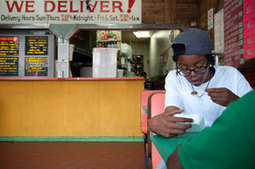"While not all agree, let's suppose, for a moment, that we are, in fact, presenting through our contemporary storytelling a relatively narrow range of the American experience. Some of the questions we ought to be asking are, is it enough to maintain the same formats, as we have, and try to entice more/different storytellers? Do we need to expand our awareness in some way to consider more broadly the particulars of this time, this particular space, and who is involved? And, fundamentally, what is it going to take to go further, to do more?"
Now here is a very thought-provoking piece about storytelling in general. I've curated it because the more businesses understand the craft of storytelling, the more effective we can be.
Warning -- there is such rich material here -- along with fabulous video examples to watch -- that you will need to carve out some time to explore everything here.
And hey -- we all live in a culture surrounded by media. It is important to keep up with shifts and changes in technology and its impact on storytelling so we can understand our daily life better -- and the opportunities open to us.
What is the biggest shift technolgy brings? Ethnographic storytelling. What the heck is that? It is when you put the camera and the storytelling into the hands of people to create and tell their story. Nothing new here -- this was pioneered by Anthropologists Sol Worth & John Adair in the 1972 book Through Navajo Eyes. The article contains several examples.
What is new is that now technology makes the ability to share our stories very easy and cheap to do -- through a proliferation of channels to share them. THAT is what is getting reinvented -- not the structure of a good story.
And technology is bringing us unique and very creative ways to craft our stories. For example, there's a link within this article to "How the Indie Audio Community Is Transforming Storytelling," This article shares a story where audio is dominant. It is great.
Other examples in the article include Localore -- a project about place-based storytelling.
What do I like about this article and the links to other articles within this piece? It asks essential questions like:
Who gets to tell the story? Who gets to ask the question that begins the story? What is the question?
When businesses and organizations start asking themselves these questions FIRST when wanting to tell a digital story, they focus on the story first. Too many people in my experience -- when wanting to tell a digital story -- get caught up in the technology first and end up spending tons of money with unhappy results. Or they think the story will emerge if they just start talking - to be edited down by the videographer into a story -- with the same unhappy results.
So read this article, its links to other articles, explore the digital story examples given, and start figuring out the following:
How can I have my customers share their stories about my organization using ethnographic storytelling? How can I leverage audio storytelling (see the article for info/examples) beyond radio & podcasts? How can I leverage location & physical space to share biz stories? How can I creatively use technology to share biz stories that reflect my/our Unique Voice & Unique Proposition?
I could comment at length on this article and its links. It has taken me awhile to curate this piece because I kept going back and dipping in for more.
So give yourself time to enjoy this creative romp exploring cutting edge electronic storytelling and all the deep insights here!
This review was written by Karen Dietz for her curated content on business storytelling at www.scoop.it/t/just-story-it ;
[Karen's right. This is a rich vein of thinking about storytelling. ~ Jeff]



 Your new post is loading...
Your new post is loading...







